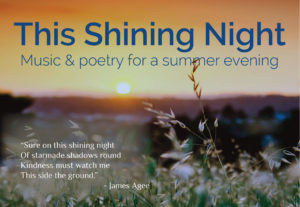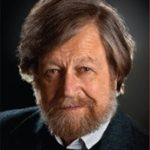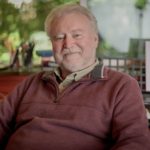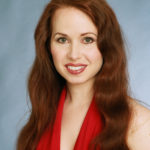
Saturday, June 10, 2023 at 8:00 pm
Pre-concert talk with director Freddie Coleman at 7:00 p.m.
“Sure on this shining night
Of starmade shadows round
Kindness must watch for me
This side the ground.”
– James Agee
Themes of love and innocence unite poets, songwriters, and four living American composers for our June concert.
Morten Lauridsen is considered one of the most important voices in modern choral music and his works are both identifiable and timeless. His Nocturnes weave motifs of night and romantic love into one integrated choral cycle.
Curve of Gold is a setting of Sara Teasdale poems that explore love’s journey as we seek, find, and sometimes lose our way. Donald Skirvin dedicated the work to the SCC in 2015, and we are delighted to present it again.
Philip Glass, one of the most prolific composers of our time, wrote Three Songs for the 350th anniversary of Quebec in 1984. It is a tightly structured trilogy of lyrics by three legendary poets and songwriters.
John Corigliano’s beautiful setting of Dylan Thomas’ poem Fern Hill transports the listener to a sonic landscape of lush groves and expansive fields, evoking a childhood almost forgotten.
I. Sa nuit d’été (Lyrics by Rainer Maria Rilke)
II. Soneto de la noche (Lyrics by Pablo Neruda
III. Sure On This Shining Night (Lyrics by James Agee
IV. Epilogue: Voici le Soir (Lyrics by Rainer Maria Rilke)

Morten Lauridsen
Morten Johannes Lauridsen (born February 27, 1943, in Colfax, WA) is a native of the Pacific Northwest, where he worked as a Forest Service firefighter and lookout (on an isolated tower near Mt. St. Helens.) He attended Whitman College before traveling south to study composition at the University of Southern California with Ingolf Dahl, Halsey Stevens, Robert Linn, and Harold Owen. He began teaching at USC in 1967 and retired after a distinguished teaching career spanning 40 years.
In 2006, Lauridsen was named an ‘American Choral Master’ by the National Endowment for the Arts. In 2007 he received the National Medal of Arts from the President in a White House ceremony, “for his composition of radiant choral works combining musical beauty, power and spiritual depth that have thrilled audiences worldwide.”
Referring to Lauridsen’s sacred music, the musicologist and conductor Nick Strimple said he was “the only American composer in history who can be called a mystic, (whose) probing, serene work contains an elusive and indefinable ingredient which leaves the impression that all the questions have been answered.”
Lauridsen’s music occupies a permanent place in the standard vocal repertoire of the Twentieth Century. The “Lauridsen Effect” has long been in evidence in the United States where there can be scarcely any choir that has never sung his music. With the Nocturnes (2005) Lauridsen undertook a particularly difficult formal challenge: to compose an integrated choral cycle that was simultaneously a triptych while allowing each of the panels to be performed separately. The Nocturnes are unusual within Lauridsen’s œuvre.
Unlike his earlier choral cycles, both of which use the work of a single poet, Lauridsen has here anthologized the verses of three twentieth-century poets, each of a different nationality: the German Rainer Maria Rilke, the Chilean Pablo Neruda, and the American James Agee. To ensure unity of conception amid this poetic diversity, the composer has cannily chosen four poems in which there are shared themes: night, romantic love, and pantheistic rapture.
“Four poems sharing a common motif of ‘Night’ provide the texts for my choral cycle Nocturnes, the American Choral Directors Association’s commissioned work for its 2005 national convention. For Rilke’s atmospheric Sa nuit d’ete (Its Summer Night), several melodic themes are supported by dense, colorful harmonies in both the choral and piano parts, leading to a climactic section where all are combined and stated simultaneously. Neruda’s Soneto de la Noche (Sonnet of the Night), from his Cien Sonetos de Amor (100 Love Sonnets), speaks of an eternal love that transcends death while reaffirming life. My a cappella setting of this gorgeous poem is predominantly quiet, serene and folk-like, utilizing direct harmonies accompanying long, lyrical vocal lines. Agee’s wondrous Sure on this Shining Night is set much like a song from the American musical theater, a genre for which I have held a life-long esteem. Rilke’s poignant Voici le soir (Night Has Come) recalls the opening bell sounds and jazz-tinged chords of the first movement and serves as an epilogue, quietly concluding this cycle of night songs as darkness descends.”
— Morten Lauridsen
II. Delicately alight
III. If I should see your eyes again
IV. A lamp in darkness
— Poetry by Sara Teasdale
Written for and dedicated to the SCC in 2015

Donald Skirvin

Sarah Mattox,
mezzo soprano
Seattle composer Donald Skirvin received The American Prize in Composition for 2020 in the professional division for shorter choral works. He has received National Endowment for the Arts (NEA) grants together with grants through ArtsWA in Washington State and numerous commissions directly through performing ensembles.
About choral composition, Skirvin says, “I want to create choral pieces whose music is deeply imbued with the words of the poet. For such a piece to be successful and effective, I think the music must arise seamlessly and inevitably from the words themselves. Anyone who listens to my music can hear that the soundscape is definitely modern. I value melody in my writing as well as rich and sometimes complex harmonic structures and shifting tonal centers. I am fond of writing unusual sonorities that tend, I think, to surprise the listener.”
Scored for soprano solo, SATB choir, and piano, Curve of Gold is a meditation on love’s journey as we seek, find, and sometimes lose our way. That journey is rarely a straight line; it curves, doubles back, leads you through thrilling adventures, and may sometimes break your heart. Curve of Gold explores that path through four vignettes, each representing a stage in this journey. The set opens with the tale of ephemeral love, comparing the eternal cycles of the moon to the brevity of love. The second movement expresses how another’s love transforms even common experience into a shining road to travel together, setting the surroundings “delicately alight.” The third movement contemplates love’s loss, and the memories of kinder times. The final movement describes how we can carry love as a beacon, a lamp, through the darkness as life reaches its journey’s end.
Love Songs, from which the lyrics of this piece are taken, is a collection of poems by the American poet Sara Teasdale. Critics have found much of Teasdale’s poetry to be full of musical language and evocative emotion. Love Songs was published in 1917 and won the Pulitzer Prize for Poetry the following year, as well as the Poetry Society of America Prize.
Curve of Gold was written for and dedicated to Freddie Coleman and the Seattle Choral Company who debuted the work on June 13, 2015.
I. There Are Some Men (Lyrics by Leonard Cohen)
II. Quand les Hommes Vivront (Lyrics by Raymond Lévesque)
III. Pierre de Soleil (Lyrics by Octavio Paz)

Philip Glass
Through his operas, his symphonies, his compositions for his own ensemble, and his wide-ranging collaborations with artists ranging from Twyla Tharp to Allen Ginsberg, Woody Allen to David Bowie, Philip Glass has had an extraordinary and unprecedented impact upon the musical and intellectual life of his times. Glass is the first composer to win a wide, multi-generational audience in the opera house, the concert hall, the dance world, in film and in popular music — simultaneously.
Glass was born in 1937 and grew up in Baltimore. He studied at the University of Chicago, the Juilliard School and in Aspen with Darius Milhaud. Finding himself dissatisfied with much of what then passed for modern music, he moved to Europe, where he studied with the legendary pedagogue Nadia Boulanger (who also taught Aaron Copland, Virgil Thomson and Quincy Jones) and worked closely with the sitar virtuoso and composer Ravi Shankar. He returned to New York in 1967 and formed the Philip Glass Ensemble — seven musicians playing keyboards and a variety of woodwinds, amplified and fed through a mixer.
The new musical style that Glass was evolving was eventually dubbed “minimalism” Glass himself never liked the term and preferred to speak of himself as a composer of “music with repetitive structures.” Much of his early work was based on the extended reiteration of brief, elegant melodic fragments that wove in and out of an aural tapestry. Or, to put it another way, it immersed a listener in a sort of sonic weather that twists, turns, surrounds, develops.
Commissioned and written for the Québec Festival 1934-1984, Three Songs for Chorus a Cappella presents three short pieces set to poems by three different North American poets. The first song, There are Some Men, is by singer-songwriter and poet Leonard Cohen (whose poetry was later the basis of an evening length song-cycle by Glass titled Book of Longing.) The second song, Quand les Hommes vivront d’Amour, by singer-songwriter/poet/artist Raymond Lévesque, is a wish for peace and happiness through love. The third song, Pierre de Soleil, by poet Octavio Paz, is a mediation on existential selflessness (“les autres qui me donnent l’existence.”)
Philip Glass has consistently written for choruses throughout his career including major operas (Satyagraha, The Voyage) and large orchestral works (symphonies Nos. 5 & 7, Passion of Ramakrishna). However, Three Songs is unique as the composer’s only a cappella choral work.

John Corigliano

Sarah Mattox,
mezzo soprano
Poetry by Dylan Thomas
I first encountered Dylan Thomas’ work in 1959, my last undergraduate year at Columbia College. It was a revelation. Both the sound and structures of Thomas’ words were astonishingly musical. Not by accident, either: “What the words meant was of secondary importance; what matters was the sound of them . . . these words were as the notes of bells, the sounds of musical instruments,” he wrote in his Poetic Manifesto of 1951. I was irresistibly drawn to translate his music into mine.
One poem captivated me: Fern Hill, about the poet’s ‘young and easy” summers at his family’s farm of the same name. I wanted to write this work as a gift for my high-school music teacher, Mrs. Bella Tillis, at Midwood High School in Brooklyn, who first encouraged my musical ambitions. She introduced Fern Hill with piano accompanying her choir.
Just as Fern Hill is an eager celebration of youth, the work was written when I was much more innocent, musically. The language that I loved at the time was the American language of Copland, Barber and Bernstein. Fern Hill is a blithe poem, yet touched by darkness; time finally holds the poet “green and dying,” but the poem itself, formally just an ABA song extended into a wide arch, sings joyously of youth and its keen perceptions. I set it for mezzo-soprano solo, chorus, and orchestra (with piano accompaniment as an option), aiming to match the forthright lyricism of the text. (The direction “with simplicity” is everywhere in the printed score.)
— John Corigliano
